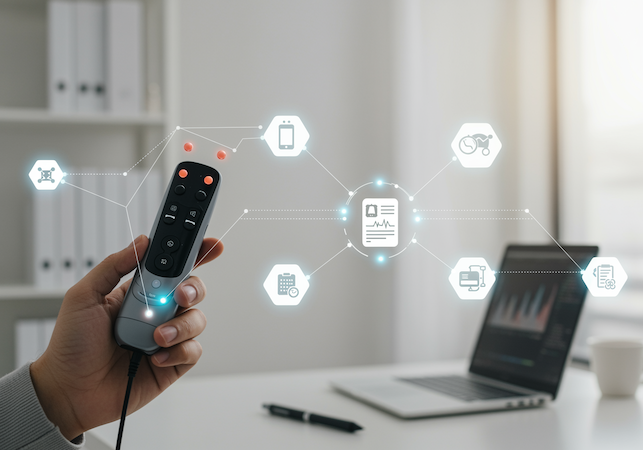Let’s cut to the chase. You’re here because manual clinical documentation is a drag on your operations, your clinicians, and potentially, your bottom line. You know the buzzwords – AI, automation, NLP – but implementing solutions to effectively automate clinical notes that actually work without creating new nightmares?
That’s the real challenge. This isn’t just about swapping keyboards for microphones; it’s about fundamentally rethinking how clinical insights are captured, structured, and utilized.
Key Takeaways
- Truly successful efforts to automate medical notes depend less on raw transcription accuracy and more on deep, bidirectional EHR integration that intelligently structures data within existing clinical workflows, avoiding superficial links that merely add clicks.
- Implementing automated clinical notes effectively requires treating it as clinical change management, prioritizing clinician buy-in through targeted benefits and workflow-specific training focused on validating AI output, not just accepting it.
- The future integration of Generative AI into clinical notes automation carries significant risk; its responsible use hinges on maintaining absolute clinician oversight for validation, focusing GenAI on drafting from structured data or summarizing, rather than autonomous note creation.
Table of Contents
- Medical Notes Automation: What It Means and Why It Matters
- Automate Medical Notes: Tools and Technologies
- Implementing Medical Notes Automation in Your Organization
- Leveraging AI Documentation to Improve Efficiency
- The Future of Medical Notes Automation in Healthcare
Medical Notes Automation: What It Means and Why It Matters
Medical notes automation isn’t just about saving time—it’s about saving your clinicians from burnout, your compliance team from audit nightmares, and your revenue cycle from drowning in vague, unbillable documentation.

If you’re still relying on manual notes or half-baked AI solutions that spit out unusable jargon, you’re leaving money on the table and risking errors that could tank care quality. Here’s what you need to know—without the fluff.
What Is Medical Notes Automation?
(No, it’s not just ChatGPT with a stethoscope.)
Medical notes automation uses AI technology to transcribe, structure, and summarize clinical encounters—accurately—into EHR-ready documentation. The goal isn’t just faster typing; it’s about transforming unstructured conversation and observation into structured, useful data within the medical documentation workflow.
The best systems:
- Pull structured data (labs, vitals, meds) directly from EHRs instead of hallucinating.
- Adapt to specialty-specific workflows (e.g., psychiatry vs. cardiology templates).
- Flag inconsistencies (missing ROS, conflicting meds) before they blow up in an audit.
Want a real-world playbook? Check our medical document automation guide for how top health systems automate clinical notes without sacrificing accuracy or compliance.
Red Flag: If your vendor claims their AI “works out of the box” without specialty tuning, run. Generic models = garbage documentation.
Key Benefits for Healthcare Professionals
(Or: How to stop wasting 2+ hours daily on notes)
Efficiency isn’t just about speed—it’s about reducing cognitive load so clinicians can focus on patients, not paperwork. Automation done right:
- Cuts documentation time by 30–50% (real-world data from AMA pilots).
- Reduces copy-paste bloat (a major target in CMS audits).
- Auto-generates billing-compliant notes (so you’re not leaving RVUs on the table).
Pro Tip: Track time saved per encounter—not just overall efficiency. If your docs still spend 10 minutes editing AI output, your system isn’t truly “automated.”
Impact on Patient Care and Communication
(Where most “AI-powered” tools fail.)
Bad automation = more screen time, less eye contact. The right solution should:
- Summarize patient interactions in natural language (no robotic templating).
- Highlight critical follow-ups (e.g., “Pt declined colonoscopy—flag for recall in 6mo”).
- Sync with patient portals for seamless after-visit summaries.
True automation in healthcare bridges the digital-human divide—it should fade into the background while surfacing only what matters for continuity of care.
Example: A well-tuned system auto-flags a diabetic patient’s non-adherence to meds in the note—triggering a nurse follow-up before the next visit.
Challenges in Traditional Clinical Note-Taking
(Or: *Why your EHR’s built-in templates suck*)
If your clinicians are still:
- Manually hunting for codes to support billing…
- Drowning in redundant free-text entries…
- Missing key details because they’re typing instead of listening…
…your clinical workflow automation is broken. The fix? Structured data capture + smart defaults.
We need to focus on alleviating these specific pain points through intelligent clinical workflow automation:
- Cognitive Overload: Clinicians juggle patient interaction, diagnostic thinking, and documentation simultaneously. Quality suffers.
- Template Tyranny: Rigid templates often don’t capture the nuance of a complex case, leading to “note bloat” or critical omissions.
- Data Silos: Information trapped in unstructured free text is hard to query, analyze, or use for broader quality improvement or research.
War Story: A 1 month retrospective audit comparing GaleAI to 3rd party coders found the human coders missed 7.9% of codes identified by GaleAI, an AI medical coding platform we helped building.
How Clinical Notes Affect Treatment Plans and Outcomes
(No, “quality” isn’t just a buzzword.)
Sloppy notes lead to:
- Missed diagnoses (e.g., buried social determinants in a wall of text).
- Denied claims (thanks to vague or unsupported MDM).
- Med errors (when allergies or interactions aren’t flagged).
Data Point: A 2023 JAMA Network Open study found that 25.9% of prior authorization denials were due to poor clinical documentation, contributing to treatment delays.
Action Item: Audit 10 random notes. If you can’t instantly find the clinical rationale for a decision, your system is failing.
Looking to build a custom medical notes automation solution? Let’s discuss your project. (No vaporware—just battle-tested tech that works.)
Automate Medical Notes: Tools and Technologies
Let’s be real—most “AI-powered” documentation tools are either glorified dictation apps or overhyped black boxes that crumble under real clinical scrutiny. Everyone’s selling some flavor of “AI medical scribe” these days.
But picking the right tools and integrating them without creating a compliance dumpster fire or a workflow nightmare? That’s where the real work lies. Get this wrong, and you’ve just bought expensive shelfware that your clinicians will actively sabotage.
Types of Automation Tools Used by Clinicians
(Spoiler: Not all “automate medical notes” solutions are created equal.)
The market’s flooded with options, but these are the only three worth your time:
- Specialty-Specific NLP Engines
- Think: Psych notes that auto-flag mental health risk factors, or cardiology templates that pre-populate ejection fractions.
- Red Flag: Generic transcription tools (looking at you, Dragon) that force docs to waste time editing jargon.
- EHR-Native Smart Templates
- Pulls structured data (meds, allergies, labs) directly from your EHR and medical record system—no copy-paste vomit.
- Pro Tip: Epic’s Hyperspace and Cerner’s PowerNotes suck less if you customize them aggressively.
- Ambient Scribes
- Listens to patient visits, then generates SOAP notes without requiring the doc to narrate like a robot.
- Gotcha: If it can’t handle cross-talk or accents, it’s useless in the wild.
Here’s the first mistake most leaders make: Obsessing over raw transcription accuracy. Yes, it matters, but it’s table stakes. The real differentiator isn’t whether the AI caught “metastatic” versus “metastasize.” It’s whether the tool:
- Integrates intelligently: Does it just dump a text blob, or does it parse, structure, and map data to the right EHR fields? (More on this next).
- Understands clinical context: Can it differentiate between patient history, assessment, and plan? Does it recognize relevant negatives?
- Adapts to your workflows: Is it customizable for different specialties, encounter types, and clinician preferences? Off-the-shelf rarely fits perfectly.
Stop looking for just transcription. You need workflow intelligence. These are the automation tools you should actually evaluate. Don’t fall for demos showing perfect conditions; pressure-test them with complex cases and accents.
Want the full breakdown? Dive into our comprehensive EHR and medical record automation guide for an in-depth exploration.
Integration with Electronic Health Records
(Where 90% of “seamless” solutions faceplant)
Your tool can have all the AI glitter—but if it doesn’t play nice with Epic/Cerner/Meditech, you’re just creating more silos. Nail this by:
- Demanding pre-built FHIR/HL7 connectors: no “custom API” hand-waving.
- Testing bidirectional flows: e.g., auto-pulled vitals should update in real time, not just display.
- Auditing for context loss: e.g., does patient information from a nephrologist’s note bleed into unrelated specialties?
- Overall contextual awareness: Does the integration trigger based on workflow events (e.g., opening a chart, starting an encounter)? Or does it require awkward manual steps?
- Data mapping: Who is responsible for mapping the AI output to your EHR’s specific fields and templates? This requires clinical informatics expertise and is never plug-and-play, despite vendor claims. FHIR helps, but it’s not magic.
What You’re Probably Doing Wrong: Accepting superficial integration. If your “integrated” tool requires clinicians to copy-paste text, manually reconcile data, or use a clunky side-panel detached from the main EHR workflow, you haven’t integrated; you’ve just added another screen.
Do This Instead: Demand detailed technical specifications for the integration before signing. Ask for case studies with your specific EHR. Budget for internal or third-party resources for the inevitable custom mapping and workflow optimization.
Ensuring HIPAA Compliance and Data Privacy
(Because your vendor’s “trust me bro” BAA isn’t enough)
If your tool touches PHI, it better be HIPAA compliant by design—not just checkbox theater.
Non-negotiables:
- End-to-end encryption (including voice recordings if using ambient AI).
- Audit trails that track who accessed what (hello, insider threats).
- Data minimization (why the hell is your dermatology tool storing SSNs?).
Think beyond the BAA checkbox:
- Data Flow Transparency: Where does the PHI actually go? Is audio processed on-device, in a private cloud, or sent to a third-party Large Language Model (LLM)? If it’s the latter, how is PHI protected in transit and at rest? Is it de-identified before hitting a less secure model? You need a data flow diagram you can trust.
- Vendor Security Audits: Don’t just accept their SOC 2 report. Dig deeper. What are their access control policies? How is data segregated? What are their breach notification procedures specifically for your data?
- Downstream Compliance: Ensure the structured data pushed to the EHR maintains its integrity and the source (AI-assisted) is traceable.
Obligatory Horror Story: Think your AI project is too advanced for basic failures? A major NYC hospital paid $3.3M (their share of a larger settlement) because a simple server misconfiguration put PHI on Google. Your AI doesn’t bypass the need for secure servers and networks. Foundational IT errors will sink any health tech, AI included.
Learn how your team can automate medical notes safely and effectively— Contact us for a consultation. (We fix compliance dumpster fires.)
Implementing Medical Notes Automation in Your Organization
Let’s get one thing straight: Even the slickest automated clinical notes system will fail if your clinicians hate using it. I’ve seen $2M “solutions” collect dust because nobody bothered to prep the actual humans who’d interact with it daily.
Here’s how to roll this out without mutiny—and actually move the needle.
Preparing Your Team for Workflow Changes
(Because “just log in and start dictating” isn’t a rollout plan)
Healthcare providers don’t resist change—they resist bad change. Your job is to make this transition feel like a lifeline, not another IT-mandated headache.
What You’re Probably Doing Wrong: Announcing the new tech via email memo, highlighting features you care about (like cost savings), and scheduling mandatory, generic training sessions. Expecting doctors to just figure out how this fits into their already insane day.
Do this instead:
- Focus relentlessly on the clinician benefit: less time charting, more time thinking/seeing patients, maybe even getting home earlier.
- Run shadow sessions before go-live—let docs see the tool actually saving time during real patient visits.
- Identify your clinical champions (usually the tech-savvy mid-career docs, not the burnt-out veterans or fresh residents).
- Kill redundant steps—if your automation in healthcare administration still requires manually reconciling meds, you’ve built a faster horse, not a car.
- Be brutally honest about the tool’s limitations. Acknowledge there will be errors and a learning curve. Emphasize the clinician remains 100% responsible for the final note’s accuracy. This manages expectations and reinforces accountability.
Red Flag: If your training consists of a 45-minute Zoom and a PDF, prepare for mass workarounds.
Best Practices for Adoption and Training
(No, your EHR vendor’s “certified trainer” won’t cut it)
Forget the traditional LMS crap. Clinicians need just-in-time learning that matches their workflow:
- Micro-training: 90-second videos showing how to correct an AI error during a visit (hint: it’s faster than typing from scratch).
- Specialty-specific playbooks: Psych notes need different shortcuts than ortho. Generic training = wasted time.
- Gamify the pain points: Offer coffee cards to the first 10 docs who flag documentation inconsistencies caught by the AI.
- Hands-On in your environment: Train directly within your EHR, showing precisely where the tool integrates, how to launch it, review output, edit efficiently, and sign off.
- Master the “review & edit”: Train clinicians how to quickly scan, verify, and correct AI-generated text. Accepting AI output blindly is malpractice waiting to happen.
Pro Tip: Steal this from our healthcare mobile app development guide—adoption spikes when you embed training inside the tool (e.g., “Hey Dr. Smith, want to auto-populate this ROS with one click?”).
Red Flag: Training programs that don’t require users to demonstrate proficiency in reviewing and editing notes within the integrated workflow before going live.
Monitoring and Evaluating Clinical Notes Automation Outcomes
(If you’re not tracking these metrics, you’re flying blind)
Most healthcare organizations measure the wrong things (lookin’ at you, “number of logins”).
Do This Instead: Define your key performance indicators (KPIs) before implementation. Establish baseline metrics. Set up dashboards to track progress and identify issues early. Treat monitoring as an ongoing process, not a one-off report. Use the data to continuously optimize the tool, training, and workflows.
Track what actually matters:
- Time-to-signature: How many minutes from visit end to finalized note? (Goal: <15 mins for 80% of encounters.)
- Throughput: Can clinicians handle slightly more volume without burning out?
- Edit rate: If docs are rewriting 70% of the AI’s output, your model needs tuning.
- Downstream impact: Are coders reporting fewer queries? Are follow-up visits better prepped thanks to structured data?
- Internal audits: Regularly audit AI-assisted notes for completeness, accuracy, and compliance, just like any other note.
Red Flag: Declaring victory based solely on adoption numbers without evidence of improved efficiency, maintained/improved quality, and clinician well-being.
Need help integrating AI-driven medical notes automation into your system? Talk to our development team. (We bake adoption science into the build.)
Leveraging AI Documentation to Improve Efficiency
Saving clinicians time is the headline benefit, sure. But if that’s all you’re getting from your investment in medical notes automation, you’re leaving serious value on the table. The real game-changer isn’t just faster notes, it’s potentially smarter documentation that ripples benefits downstream – if you leverage the AI platform strategically.
Here’s how to make your AI documentation work harder than your residents.
Using AI Platforms to Enhance Documentation
(Hint: If it’s not reducing cognitive load, you’re doing it wrong)
Your clinical notes automation should feel like a scribe who never sleeps, not another pop-up demanding attention. The winners:
- Auto-summarize patient histories into actionable bullets (no more novel-length H&Ps)
- Flag inconsistencies in real-time (e.g., “You documented ‘no chest pain’ but ordered a troponin—intentional?”)
- Generate billing-ready MDM that actually supports your level of care
Pro Tip: The best AI medical records summary tools preserve nuance—they don’t turn “patient cried when discussing her mother’s death” into “patient upset.”
Red Flag: If your AI can’t handle “ums” and “you knows” in natural speech, it’ll butcher psych notes.
How Medical Notes Automation Impacts the Revenue Cycle
(Where bad documentation goes to die—and take your reimbursement with it)
CMS isn’t playing nice anymore. If your notes don’t clearly support medical necessity, you’re leaving money on the table:
- Under-documented MDM → Downcoded visits (that “level 4” just became a level 3)
- Missing ROS elements → Denied claims (yes, they’re actually checking)
- Vague treatment plans → Delayed auths (because no one can tell what you’re doing)
Do This Instead: Integrate Clinical Documentation Integrity (CDI) spcialists and coding perspectives early when selecting and configuring your automation tool. Ensure the structured output maps cleanly to billing requirements. Monitor metrics like query rates, denial rates for documentation reasons, and Case Mix Index (CMI) shifts post-implementation.
Red Flag: Vendors making vague claims about revenue cycle uplift without demonstrating exactly how their tool’s output translates into better, more easily codable documentation accepted by your billing processes.
Streamlining Treatment Plans and Clinical Decisions
(Especially in high-stakes areas like mental health)
The right automation doesn’t just document—it improves care:
- Risk stratification: Auto-flagging PHQ-9 scores ≥20 for immediate social work referral
- Medication tracking: Visualizing SSRI response trends across notes (no more flipping through 12 progress notes)
- Continuity of care: Surfacing last session’s “homework assignment” at the top of today’s note
Reality Check: Delivering on this requires more than basic transcription or note generation. It demands sophisticated NLP, integration with clinical decision support systems (CDSS), and careful validation. Don’t expect your simple scribe tool to suddenly start diagnosing patients.
Do This Instead: Think long-term. As you implement documentation automation, consider how the structured data being captured could eventually feed into broader clinical intelligence initiatives. Prioritize tools that produce clean, structured output, even if the immediate use case is just note generation.
Ready to turn your EHR into something that actually helps instead of hurts? Our healthcare AI team lives for this stuff.
The Future of Medical Notes Automation in Healthcare
So, we’ve covered the tools, the messy integration, the implementation headaches, and the downstream potential. But where is this all heading? If you’re just aiming to catch up with today’s tech, you’re already behind.
The real strategic advantage comes from anticipating what’s next in medical notes automation and building towards it.
Emerging Trends in Healthcare Automation
(Spoiler: It’s not just bigger LLMs)
The next wave of medical notes automation won’t just document—it will:
- Auto-generate patient-facing summaries in plain language
- Predict documentation gaps before they happen
- Integrate with wearable data to populate notes with actual info
Red Flag: Vendors pushing “real-time ambient documentation” without specialty-specific tuning are selling snake oil. Psych notes ≠ ED notes ≠ annual physicals.
The Role of Generative AI in Clinical Notes Creation
(And no, it won’t replace your clinicians—but it will expose the lazy ones)
Generative AI that’s actually useful in healthcare must:
- Preserve clinical intent
- Respect workflow boundaries (no, docs don’t want AI “suggestions” mid-conversation)
- Show its work (every auto-generated element should be traceable to a specific part of the encounter)
Pro Tip: The best systems let clinicians dictate how generative AI helps—like choosing between “SOAP format” or “narrative style” before the visit even starts.
How to use generative AI responsibly (for now):
- Structured Data -> Draft Narrative: Feed the AI structured data points (vitals, exam findings, assessment keywords) and have it draft the narrative sections for clinician review and editing.
- Summarization & Synthesis: Use it to summarize lengthy histories or previous notes before the clinician starts their own documentation.
- Strict Human Oversight: This is non-negotiable. Every single word generated by AI that enters the official medical record must be reviewed, edited, and explicitly approved by a qualified clinician. Build workflows and UI that enforce this accountability.
- PHI Safeguards: If using third-party GenAI models, you need ironclad guarantees (or better yet, private instances and robust de-identification protocols) for how Protected Health Information is handled. The standard API agreement won’t cut it.
Red Flag: Any vendor suggesting their generative AI can operate autonomously or claiming near-perfect accuracy without clinician validation. Treat these claims with extreme skepticism. Black box AI has no place in high-stakes clinical documentation.
Building Scalable, Compliant Automation Systems
(Where expensive pilots go to die)
Moving from a pilot project in one department to an enterprise-wide standard requires a different level of planning. Scalability and compliance aren’t features you bolt on later; they need to be baked in from the start.
Where Scale-Ups Fail:
- Ignoring infrastructure: Underestimating the compute resources, API stability, and network bandwidth needed to support hundreds or thousands of concurrent users leveraging AI tools.
- Inconsistent implementation: Allowing different departments or sites to adopt different tools or configurations, leading to data silos and compliance nightmares.
- Compliance as an afterthought: Failing to embed privacy and security reviews throughout the scaling process, leading to vulnerabilities exposed only after broad deployment.
Building for the Long Haul:
- Adopt a platform mindset: Favor solutions built on scalable, reliable infrastructure with robust APIs that allow integration with other systems. Avoid brittle point solutions that don’t play well with others.
- Establish central governance: Define clear organizational policies for tool selection, configuration standards, data handling, security protocols, user training, and quality monitoring. Consistency is key for managing risk at scale.
- Automate compliance checks: Where possible, build automated checks and monitoring into your deployment pipeline (DevSecOps principles) to catch potential compliance issues early.
- Plan for evolution: The AI landscape is changing rapidly. Choose partners and build systems that are adaptable and allow for upgrading models or incorporating new capabilities without requiring a complete rip-and-replace.
The future of medical notes automation won’t be about eliminating clinicians from the loop, but about augmenting them with intelligent tools that handle the drudgery, surface insights, and allow them to focus on what matters most – patient care.
Getting there requires not just adopting new technology, but strategically planning for its integration, governance, and evolution within the complex healthcare ecosystem.
Planning to innovate in clinical documentation? Partner with us to bring your vision to life. (We’ve shipped AI tools that actually get used.)
Frequently Asked Questions
What is the difference between clinical notes automation and medical transcription?
Medical transcription converts voice to text. Clinical notes automation goes further, structuring that text, integrating it into EHR fields, and potentially adding clinical intelligence or summarization, aiming to streamline the entire documentation workflow, not just typing.
Is medical notes automation suitable for mental health practioners?
Yes, particularly for structuring lengthy session narratives, tracking progress, and reducing documentation burden. However, the nuanced nature of mental health notes requires extremely careful clinician review and editing of any AI-generated content to ensure accuracy and context.
Can I customize the output format of automated documentation?
Often, yes. Better automation tools allow configuration to map extracted information into specific fields or templates required by your EHR or preferred format. This usually requires setup effort and may depend on the tool’s flexibility and integration capabilities.
What are the risks of automating medical notes?
Key risks include AI errors impacting accuracy, clinicians becoming overly reliant and reducing critical review, potential HIPAA/privacy breaches if security isn’t robust, workflow disruption from poor integration, and biases inherent in AI models influencing notes.
How does automation affect the doctor-patient relationship?
Ideally, it improves it by reducing keyboard time and allowing more direct interaction. However, ambient listening tools must be implemented transparently to avoid making patients feel uncomfortable or constantly monitored during sensitive conversations.
Are there any free tools to start with clinical documentation automation?
True, HIPAA-compliant clinical notes automation platforms are rarely free due to complexity, integration, and security requirements. Basic dictation software might be free or low-cost but lacks the advanced structuring and EHR integration features of dedicated automation tools.
What support is available for onboarding staff to these tools?
Support varies. Vendors usually provide initial training, manuals, and help desks. Effective onboarding often also requires internal resources like designated “super users,” customized workflow training tailored to specific roles, and ongoing technical/clinical support post-launch.



